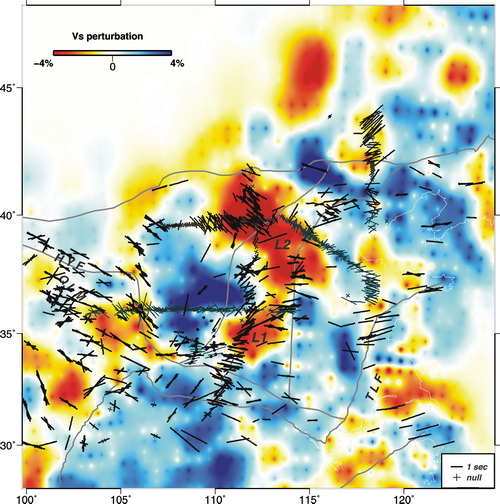No direct correlation of mantle flow beneath the North China Craton to the India-Eurasia collisionUpdate time:11 11, 2011
Professor ZHAO Liang and his team investigate deformation beneath the North China Craton and the Qilian Mountain region between the Haiyuan and Kunlun faults, both of which are located immediately to the northeast of the Tibetan Plateau. They present teleseismic shear wave splitting parameters from 299 broad-band stations. These stations provided good spatial coverage in mapping upper-mantle deformation beneath the North China Craton and the Qilian Mountain. The backazimuth dependence of fast directions from stations located within theQilian Mountain region indicates a complex anisotropy pattern. A multilayer anisotropy and/or anisotropy with a dipping symmetry axis may exist beneath the Qilian Mountain. The overlapping or underthrusting of material evident in anisotropy from this region may be a long-range effect of the India–Eurasia collision. The central North China Craton showed spatially coherent fast directions and the shear wave velocity anomalies within the upper mantle. These patterns suggest horizontal deflection of a regional mantle upwelling, possibly originating from the mantle transition zone. Anisotropy with large delay times was observed in the vicinity of Shanxi rift system. High ∂lnVS/∂lnVP values for the upper mantle indicate that anisotropy in this area is enhanced by vertically aligned melt-filled fissures. Their results suggest that the dynamic processes beneath the central North China Craton are not directly related to the India–Eurasia collision.
Figure 1. Splitting measurements obtained by this study (thick bars) and from previous studies (thin bars) overlaid on a tomographic image of the region.(Image by ZHAO)
Figure 2. Schematic diagram showing a regional interpretation of splitting parameter results.(Image by ZHAO) Zhao et al. No direct correlation of mantle flow beneath the North China Craton to the India-Eurasia collision: constraints from new SKS wave splitting measurements. Geophysical Journal International,2011, 187: 1027-1037 (Download Here)
|
Contact
Related Articles
Reference
|
-
SIMSSecondary Ion Mass Spectrometer Laboratory
-
MC-ICPMSMultiple-collector ICPMS Laboratory
-
EM & TEMElectron Microprobe and Transmission Electron Microscope Laboratory
-
SISolid Isotope Laboratory
-
StIStable Isotope Laboratory
-
RMPARock-Mineral Preparation and Analysis
-
AAH40Ar/39Ar & (U-Th)/He Laboratory
-
EMLElectron Microscopy Laboratory
-
USCLUranium Series Chronology Laboratory
-
SASeismic Array Laboratory
-
SEELaboratory of Space Environment Exploration Laboratory
-
PGPaleomagnetism and Geochronology Laboratory
-
BioMNSFrance-China Bio-mineralization and Nano-structure Laboratory

 Print
Print Close
Close

